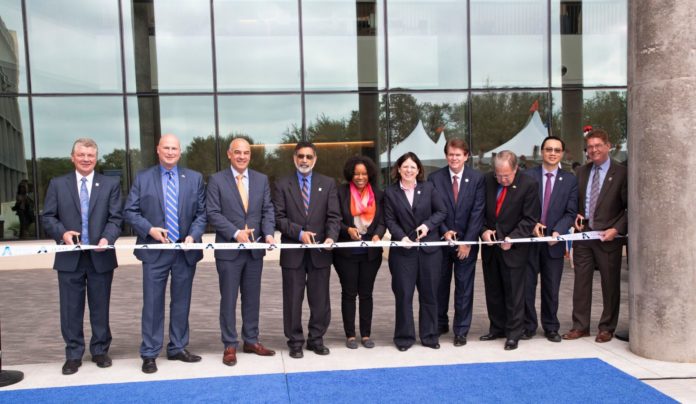The University of Texas at Arlington on Friday opened its new $125 million Science & Engineering Innovation & Research building, a state-of-the-art facility that will contribute to pushing the University forward as a leading health science research and teaching institution.
Almost $30 million in active research grants move with UTA’s faculty into the new facility, which will focus on interdisciplinary research around major health science challenges, such as brain health, cancer, cardiovascular health, healthy aging and rehabilitative medicine.
“We want to thank our champions in the legislature, the Board of Regents, the University of Texas System leadership and the campus community for believing in our vision,” said UTA President Vistasp Karbhari. “SEIR is the embodiment of our health science focus, bringing together research neighborhoods, collaborative spaces, teaching facilities and areas where faculty, staff and students can engage with one another as well as experts from the community, the corporate world and non-profit sectors.”
The SEIR building also incorporates a novel “science-on-display” concept with glass interior walls that allow everyone who walks through the building to be part of the discovery process.
“The building itself is a space that will catalyze and accelerate our teaching and research efforts,” said Duane Dimos, UTA’s vice president for research. “As an urban-serving Carnegie R-1 research university, we needed a space that could act as the focus for an innovation ecosystem to drive our regional economy and strengthen North Texas as a center for biotechnology and health science research.”
Arlington Mayor Jeff Williams said the SEIR is a critical contribution to the City of Arlington and the region.
“I have watched this building go up from the day of groundbreaking and I am hugely impressed with the final result,” Williams said. “SEIR will make a big difference to students and faculty, but also to the Arlington community at large. I foresee great solutions coming out of SEIR, for medical discoveries, drug development and new ways to treat health issues like cancer.”
State representatives Tony Tinderholt and Chris Turner also participated in the inaugural event.
Key features of the building:
• Four-story research laboratory wing and two-story instructional classroom wing
• 229,000-square-foot building adding 900 teaching seats and 12 research “neighborhoods” to prepare the next generation of leaders in health and science
• A science-on-display design includes glass interior walls allowing students and visitors to view collaborative work performed in research spaces
• Research neighborhoods create functional spaces for collaborative interdisciplinary research in targeted areas of health science, including: brain health, cancer, cardiovascular health, healthy aging and rehabilitative medicine
• Sustainable design and build, with high energy-efficiency heating and cooling systems, water conservation practices, and sustainable materials for flooring and interior finishes
Project architects for the building were Houston-based Page Southerland Page Inc. and Portland-based ZGF Architect LLC. Contractor on the project was AECOM Hunt.
Helping students pursue their dreams is an important part of SEIR. Biology doctoral student and military veteran Marquerite “Maya” Herzog, who spoke at today’s inauguration, will be utilizing SEIR resources to study the molecular basis of changes in behavior when an individual loses an aggressive conflict. Herzog’s interest in this issue grew from her experiences as a military veteran and her extensive work with military personnel returning from Iraq and Afghanistan with combat-induced Post-Traumatic Stress Disorder, or PTSD.
“The North Texas Genome Center at SEIR has high-quality sequencing equipment that will allow me to identify the genes and the proteins associated with submissiveness and self-isolation after losing a conflict, and subsequent recovery,” Herzog said. “By studying these genetic components of behavior, I will be able to provide answers not only for the biological sciences but potentially across other disciplines such as psychology and sociology, environmental science, resource management and education.”
The North Texas Genome Center resides in SEIR and will support research across genomics, bioinformatics, cancer, immunotherapy, cardiovascular health, brain health and healthy aging, while making high-throughput sequencing available to hospitals and clinicians in North Texas and beyond. By the end of 2018, the Center will house five Illumina NovaSeq-6000 cutting edge genome sequencing instruments, with a projected sequencing capacity equivalent to 25,000 human genomes per year.
SEIR has attracted close to 30 new faculty to UTA from prestigious research institutions around the country over the past three years, including Sloan Kettering Cancer Center in New York, the Harvard TH Chan School of Public Health, UT Southwestern Medical Center, The Border Biomedical Research Center at UT El Paso and the University of Wisconsin-Madison.
“One of the reasons I came to UTA was because of the SEIR building project, which really catapults UTA into a new level in teaching and research,” said Mark Pellegrino, a UTA assistant professor of biology newly installed in SEIR. “I look forward to collaborating with my colleagues across multiple disciplines in this new environment.”






